Crystal Structure, Infrared Reflection Spectrum, and Improved Microwave Dielectric Characteristics of Ba4Sm28/3Ti18O54 Ceramics via One-Step Reaction Sintering
Abstract
:1. Introduction
2. Materials and Methods
3. Results and Discussion
4. Conclusions
Author Contributions
Funding
Institutional Review Board Statement
Informed Consent Statement
Data Availability Statement
Conflicts of Interest
References
- Reaney, I.M.; Iddles, D. Microwave dielectric ceramics for resonators and filters in mobile phone networks. J. Am. Ceram. Soc. 2006, 89, 2063–2072. [Google Scholar] [CrossRef]
- Shehbaz, M.; Du, C.; Zhou, D.; Xia, S.; Xu, Z. Recent progress in dielectric resonator antenna: Materials, designs, fabrications, and their performance. Appl. Phys. Rev. 2023, 10, 021303. [Google Scholar] [CrossRef]
- Yang, H.; Zhang, S.; Yang, H.; Wen, Q.; Yang, Q.; Gui, L.; Zhao, Q.; Li, E. The latest process and challenges of microwave dielectric ceramics based on pseudo phase diagrams. J. Adv. Ceram. 2021, 10, 885–932. [Google Scholar] [CrossRef]
- Luo, W.; Yan, S.; Zhou, J. Ceramic-based dielectric metamaterials. Interdiscip. Mater. 2022, 1, 11–27. [Google Scholar] [CrossRef]
- Wang, G.; Fu, Q.; Guo, P.; Hu, M.; Wang, H.; Yu, S.; Zheng, Z.; Luo, W. Crystal structure, spectra analysis and dielectric characteristics of Ba4M28/3Ti18O54 (M = La, Pr, Nd, and Sm) microwave ceramics. Ceram. Int. 2021, 47, 1750–1757. [Google Scholar] [CrossRef]
- Guo, Y.; Wang, Z.; Li, J. Sintering Behavior, Microstructure and Microwave Dielectric Properties of Li2TiO3-Based Solid Solution Ceramics with Lithium Fluoride Addition for Low-Temperature Co-Fired Ceramic Applications. Coatings 2023, 13, 1732. [Google Scholar] [CrossRef]
- Liu, K.; Shi, L.; Wang, X.; Liu, C.; Li, J.; Liao, Y.; Jin, L.; Zhang, D.; Zhang, H. Li+ enrichment to improve the microwave dielectric properties of Li2ZnTi3O8 ceramics and the relationship between structure and properties. J. Eur. Ceram. Soc. 2023, 43, 1483–1491. [Google Scholar] [CrossRef]
- Zhang, Q.; Su, H.; Peng, R.; Huang, F.; Wu, X.; Tang, X. Effect of phase, chemical bond and vibration characteristics on the microwave dielectric properties of temperature-stable Zn1−x(Li0.5Bi0.5)xMoxW1−xO4 ceramics. J. Eur. Ceram. Soc. 2022, 42, 2813–2819. [Google Scholar] [CrossRef]
- Wu, F.; Zhou, D.; Du, C.; Xu, D.M.; Li, R.T.; Shi, Z.Q.; Darwish, M.A.; Zhou, T.; Jantunen, H. Design and Fabrication of a Satellite Communication Dielectric Resonator Antenna with Novel Low Loss and Temperature-Stabilized (Sm1−xCax)(Nb1−xMox)O4 (x = 0.15–0.7) Microwave Ceramics. Chem. Mater. 2023, 35, 104–115. [Google Scholar] [CrossRef]
- Zhang, X.; Fang, Z.; Yang, H.; Zhao, P.; Zhang, X.; Li, Y.; Xiong, Z.; Yang, H.; Zhang, S.; Tang, B. Lattice evolution, ordering transformation and microwave dielectric properties of rock-salt Li3+xMg2−2xNb1−xTi2xO6 solid-solution system: A newly developed pseudo ternary phase diagram. Acta Mater. 2021, 206, 116636. [Google Scholar] [CrossRef]
- Wang, G.; Fu, Q.; Zha, L.; Hu, M.; Huang, J.; Zheng, Z.; Luo, W. Microwave dielectric characteristics of tungsten bronze-type Ba4Nd28/3Ti18−yGa4y/3O54 ceramics with temperature stable and ultra-low loss. J. Eur. Ceram. Soc. 2022, 42, 154–161. [Google Scholar] [CrossRef]
- Yao, G.; Zhao, J.; Lu, Y.; Liu, H.; Pei, C.; Ding, Q.; Chen, M.; Zhang, Y.; Li, D.; Wang, F. Microwave dielectric properties of Li3TiO3F oxyfluorides ceramics. Crystals 2023, 13, 897. [Google Scholar] [CrossRef]
- Liu, X.; Wang, Z.; She, X.; Jia, Q.; Li, J. Improved microstructure and high quality factor of Li2Ti0.9(Zn1/3Ta2/3)0.1O3 microwave ceramics with LiF additive for LTCC applications. J. Eur. Ceram. Soc. 2023, 43, 1469–1476. [Google Scholar] [CrossRef]
- Wu, F.F.; Zhou, D.; Du, C.; Sun, S.K.; Pang, L.X.; Jin, B.B.; Qi, Z.M.; Varghese, J.; Li, Q.; Zhang, X.Q. Temperature stable Sm(Nb1−xVx)O4 (0.0≤ x ≤ 0.9) microwave dielectric ceramics with ultra-low dielectric loss for dielectric resonator antenna applications. J. Mater. Chem. C 2021, 9, 9962–9971. [Google Scholar] [CrossRef]
- Wu, F.F.; Zhou, D.; Du, C.; Jin, B.B.; Li, C.; Qi, Z.M.; Sun, S.; Zhou, T.; Li, Q.; Zhang, X.Q. Design of a Sub-6 GHz Dielectric Resonator Antenna with Novel Temperature-Stabilized (Sm1−xBix)NbO4 (x = 0–0.15) Microwave Dielectric Ceramics. ACS Appl. Mater. Interfaces 2022, 14, 7030–7038. [Google Scholar] [CrossRef]
- Zhou, D.; Pang, L.X.; Wang, D.W.; Reaney, I.M. BiVO4 based high k microwave dielectric materials: A review. J. Mater. Chem. C 2018, 6, 9290–9313. [Google Scholar] [CrossRef]
- Zhou, D.; Pang, L.X.; Wang, D.W.; Li, C.; Jin, B.B.; Reaney, I.M. High permittivity and low loss microwave dielectrics suitable for 5G resonators and low temperature co-fired ceramic architecture. J. Mater. Chem. C 2017, 5, 10094–10098. [Google Scholar] [CrossRef]
- Hu, X.; Chen, X.; Wu, S. Preparation, properties and characterization of CaTiO3-modified Pb (Fe1/2Nb1/2)O3 dielectrics. J. Eur. Ceram. Soc. 2003, 23, 1919–1924. [Google Scholar] [CrossRef]
- Luo, T.; Shan, X.; Zhao, J.; Feng, H.; Zhang, Q.; Yu, H.; Liu, J. Improvement of quality factor of SrTiO3 dielectric ceramics with high dielectric constant using Sm2O3. J. Am. Ceram. Soc. 2019, 102, 3849–3853. [Google Scholar] [CrossRef]
- Ma, F.S.; Zeng, Q.; Feng, Y.Z.; Yao, C.F.; Guo, C.C. Crystal structure and microwave dielectric properties of LiNb0.6Ti0.5O3 ceramics with Zn and Nb co-doped. Mater. Sci. Eng. B 2022, 285, 115919. [Google Scholar] [CrossRef]
- Fang, Z.X.; Tang, B.; Li, E.; Zhang, S.R. High-Q microwave dielectric properties in the Na0.5Sm0.5TiO3+Cr2O3 ceramics by one synthetic process. J. Alloys Compd. 2017, 705, 456–461. [Google Scholar] [CrossRef]
- Yu, T.; Yang, Q.; Feng, H.; Yu, H. Phase composition and microwave dielectric properties of Ca0.128Ba0.032Sm0.46Li0.3TiO3 ceramics with alumina addition. J. Eur. Ceram. Soc. 2022, 42, 1480–1485. [Google Scholar] [CrossRef]
- Xiong, Z.; Zhang, X.; Tang, B.; Yang, C.; Fang, Z.; Zhang, S. Characterization of structure and properties in CaO-Nd2O3-TiO2 microwave dielectric ceramic modified by Al2O3. Mater. Charact. 2021, 176, 111108. [Google Scholar] [CrossRef]
- Ma, Z.; Guo, W.; Yue, Z. Microwave dielectric properties of Al-doped Ba4(Sm, Nd)9.33Ti18O54 ceramics added with TiO2 and sintered in oxygen. Ceram. Int. 2022, 48, 12906–12913. [Google Scholar] [CrossRef]
- Li, L.; Wang, X.; Luo, W.; Wang, S.; Yang, T.; Zhou, J. Internal-strain-controlled tungsten bronze structural ceramics for 5G millimeter-wave metamaterials. J. Mater. Chem. C 2021, 9, 14359–14370. [Google Scholar] [CrossRef]
- Ohsato, H. Science of tungstenbronze-type like Ba6−3xR8+2xTi18O54 (R = rare earth) microwave dielectric solid solutions. J. Eur. Ceram. Soc. 2001, 21, 2703–2711. [Google Scholar] [CrossRef]
- Chen, X.M.; Li, Y. A-and B Site Cosubstituted Ba6−3xSm8+2xTi18O54 Microwave Dielectric Ceramics. J. Am. Ceram. Soc. 2002, 85, 579–584. [Google Scholar] [CrossRef]
- Okudera, H.; Nakamura, H.; Toraya, H.; Ohsato, H. Tungsten Bronze-Type Solid Solutions Ba6−3xSm8+2xTi18O54 (x = 0.3, 0.5, 0.67, 0.71) with Superstructure. J. Solid State Chem. 1999, 142, 336–343. [Google Scholar] [CrossRef]
- Wu, S.; Li, Y.; Chen, X. Raman spectra of Ba6−3xSm8+2xTi18O54 solid solution. J. Phys. Chem. Solids 2003, 64, 2365–2368. [Google Scholar] [CrossRef]
- Xiong, Z.; Tang, B.; Yang, C.; Zhang, S. Correlation between structures and microwave dielectric properties of Ba3.75Nd9.5−xSmxTi17.5(Cr1/2Nb1/2)0.5O54 ceramics. J. Alloys Compd. 2018, 740, 492–499. [Google Scholar] [CrossRef]
- Chen, X.; Qin, N.; Li, Y. Microstructures and Microwave Dielectric Characteristics of Ba6−3x(Sm1−yLay)8+2xTi18O54 Solid Solutions (x = 2/3 and 0.75). J. Electroceram. 2002, 9, 31–35. [Google Scholar] [CrossRef]
- Wang, G.; Fu, Q.; Shi, H.; Tian, F.; Wang, M.; Yan, L.; Zheng, Z.; Luo, W. Suppression of oxygen vacancies generation in Ba6−3xSm8+2xTi18O54 (x = 2/3) microwave dielectric ceramics through Pr substitution. Ceram. Int. 2019, 45, 22148–22155. [Google Scholar] [CrossRef]
- Santha, N.; Sebastian, M. Low temperature sintering and microwave dielectric properties of Ba4Sm9.33Ti18O54 ceramics. Mater. Res. Bull. 2008, 43, 2278–2284. [Google Scholar] [CrossRef]
- Xu, Y.; Huang, G.; He, Y. Sol-gel preparation of Ba6−3xSm8+2xTi18O54 microwave dielectric ceramics. Ceram. Int. 2005, 31, 21–25. [Google Scholar] [CrossRef]
- Guo, Y.; Kakimoto, K.I.; Ohsato, H. Microwave dielectric properties of Ba6−3xSm8+2xTi18O54 (x = 2/3) ceramics produced by spark plasma sintering. Jpn. J. Appl. Phys. 2003, 42, 7410. [Google Scholar] [CrossRef]
- Du, W.; Lu, K.; He, B.; Zhou, X.; Huang, X.; Qi, J.; Lu, T. Direct tape casting of Al2O3/AlN slurry for AlON transparent ceramic wafers via one-step reaction sintering. J. Eur. Ceram. Soc. 2023, 43, 3538–3543. [Google Scholar] [CrossRef]
- Liang, Z.; Huang, R.; Xie, T.; Zhang, Y.; Lin, H.T.; Dai, Y. Improvement of piezoelectric properties of Bi4Ti3O12 ceramics by Mn/Ta co-doping and direct reaction sintering. Ceram. Int. 2023, 49, 20920–20928. [Google Scholar] [CrossRef]
- Zhou, H.; Wang, H.; Chen, Y.; Li, K.; Yao, X. Microwave Dielectric Properties of BaTi5O11 Ceramics Prepared by Reaction-Sintering Process with the Addition of CuO. J. Am. Ceram. Soc. 2008, 91, 3444–3447. [Google Scholar] [CrossRef]
- Luo, T.; Yang, Q.; Yu, H.; Liu, J. Formation mechanism and microstructure evolution of Ba2Ti9O20 ceramics by reaction sintering method. J. Am. Ceram. Soc. 2020, 103, 1079–1087. [Google Scholar] [CrossRef]
- Yao, G.; Liu, P.; Zhang, H. Microwave dielectric properties of Li2MgTi3O8 ceramics produced by reaction-sintering method. J. Mater. Sci. Mater. Electron. 2013, 24, 1128–1131. [Google Scholar] [CrossRef]
- Li, J.; Xu, P.; Qiu, T.; Yao, L. Sintering characteristics and microwave dielectric properties of 0.5Ca0.6La0.267TiO3-0.5Ca(Mg1/3Nb2/3)O3 ceramics prepared by reaction-sintering process. J. Rare Earths 2018, 36, 404–408. [Google Scholar] [CrossRef]
- Wang, G.; Zhang, D.; Gan, G.; Yang, Y.; Rao, Y.; Xu, F.; Huang, X.; Liao, Y.; Li, J.; Liu, C. Synthesis, crystal structure and low loss of Li3Mg2NbO6 ceramics by reaction sintering process. Ceram. Int. 2019, 45, 19766–19770. [Google Scholar] [CrossRef]
- Qu, X.; He, S.; Li, Q.; Deng, S.; Xiao, Y.; Liu, K.; Chen, X.; Liang, J.; Zhou, H. Microwave dielectric properties of Ca1.15RE0.85Al0.85Ti0.15O4 (RE = Nd, La, Y) ceramics prepared by the reaction sintering method. Ceram. Int. 2023, 49, 716–721. [Google Scholar] [CrossRef]
- Zhou, S.; Wu, Q.; Xu, H.; Luan, X.; Hu, S.; Zhou, X.; He, S.; Wang, X.; Zhang, H.; Chen, X. Synthesis and characterization of reaction sintered CaTiO3-LnAlO3 (Ln = La, Nd) ceramics. Ceram. Int. 2021, 47, 32433–32437. [Google Scholar] [CrossRef]
- Yang, T.; Han, Z.; Liu, P.; Guo, B. Microwave dielectric properties of Mg4Nb2O9 ceramics with excess Mg(OH)2 produced by a reaction-sintering process. Ceram. Int. 2015, 41, S572–S575. [Google Scholar] [CrossRef]
- Tsai, W.C.; Liou, Y.H.; Liou, Y.C. Microwave dielectric properties of MgAl2O4-CoAl2O4 spinel compounds prepared by reaction-sintering process. Mater. Sci. Eng. B 2012, 177, 1133–1137. [Google Scholar] [CrossRef]
- Zhao, Y.; Zhang, P. Preparation for ultra-low loss dielectric ceramics of ZnZrNb2O8 by reaction-sintering process. J. Alloys Compd. 2016, 672, 630–635. [Google Scholar] [CrossRef]
- Xing, C.; Zhang, Y.; Tao, B.; Wu, H.; Zhou, Y. Crystal structure, infrared spectra and microwave dielectric properties of low-firing La2Zr3(MoO4)9 ceramics prepared by reaction-sintering process. Ceram. Int. 2019, 45, 22376–22382. [Google Scholar] [CrossRef]
- Templeton, A.; Wang, X.; Penn, S.J.; Webb, S.J.; Cohen, L.F.; Alford, N.M. Microwave dielectric loss of titanium oxide. J. Am. Ceram. Soc. 2000, 83, 95–100. [Google Scholar] [CrossRef]
- Pullar, R.C.; Penn, S.J.; Wang, X.; Reaney, I.M.; Alford, N.M. Dielectric loss caused by oxygen vacancies in titania ceramics. J. Eur. Ceram. Soc. 2009, 29, 419–424. [Google Scholar] [CrossRef]
- Kotomin, E.A.; Eglitis, R.; Popov, A.I. Charge distribution and optical properties of and F centres in crystals. J. Phys. Condens. Matter 1997, 9, L315. [Google Scholar] [CrossRef]
- Popov, A.; Kotomin, E.; Maier, J. Basic properties of the F-type centers in halides, oxides and perovskites. Nucl. Instrum. Methods Phys. Res. Sect. B Beam Interact. Mater. At. 2010, 268, 3084–3089. [Google Scholar] [CrossRef]
- He, L.; Yu, H.; Zeng, M.; Luo, T.; Liu, J. 0.73ZrTi2O6-0.27MgNb2O6 microwave dielectric ceramics modified by Al2O3 addition. J. Am. Ceram. Soc. 2018, 101, 5110–5119. [Google Scholar] [CrossRef]
- Negas, T. BaTi4O9/Ba2Ti9O20-Based Ceramics Resurrected for Modern Microwave Applications. Am. Ceram. Soc. Bull. 1993, 72, 80–89. [Google Scholar]
- Nomura, S.; Tomaya, K.; Kaneta, K. Effect of Mn doping on the dielectric properties of Ba2Ti9O20 ceramics at microwave frequency. Jpn. J. Appl. Phys. 1983, 22, 1125. [Google Scholar] [CrossRef]
- Yao, X.; Lin, H.; Chen, W.; Luo, L. Anti-reduction of Ti4+ in Ba4.2Sm9.2Ti18O54 ceramics by doping with MgO, Al2O3 and MnO2. Ceram. Int. 2012, 38, 3011–3016. [Google Scholar] [CrossRef]
- Huang, B.; Yan, Z.; Lu, X.; Wang, L.; Fu, Z.; Zhang, Q. “Dark hole” cure in Ba4.2Nd9.2Ti18O54 microwave dielectric ceramics. Ceram. Int. 2016, 42, 10758–10763. [Google Scholar] [CrossRef]
- Guo, W.; Zhang, J.; Luo, Y.; Yue, Z.; Li, L. Microwave dielectric properties and thermally stimulated depolarization of Al-doped Ba4(Sm, Nd)9.33Ti18O54 ceramics. J. Am. Ceram. Soc. 2019, 102, 5494–5502. [Google Scholar] [CrossRef]
- Hakki, B.; Coleman, P.D. A dielectric resonator method of measuring inductive capacities in the millimeter range. IRE Trans. Microw. Theory Tech. 1960, 8, 402–410. [Google Scholar] [CrossRef]
- Momma, K.; Izumi, F. VESTA 3 for three-dimensional visualization of crystal, volumetric and morphology data. J. Appl. Crystallogr. 2011, 44, 1272–1276. [Google Scholar] [CrossRef]
- Rietveld, H.M. A profile refinement method for nuclear and magnetic structures. J. Appl. Crystallogr. 1969, 2, 65–71. [Google Scholar] [CrossRef]
- Toby, B.H. EXPGUI, a graphical user interface for GSAS. J. Appl. Crystallogr. 2001, 34, 210–213. [Google Scholar] [CrossRef]
- Shannon, R.D. Dielectric polarizabilities of ions in oxides and fluorides. J. Appl. Phys. 1993, 73, 348–366. [Google Scholar] [CrossRef]
- Guo, H.H.; Zhou, D.; Liu, W.F.; Pang, L.X.; Wang, D.W.; Su, J.Z.; Qi, Z.M. Microwave dielectric properties of temperature-stable zircon-type (Bi, Ce)VO4 solid solution ceramics. J. Am. Ceram. Soc. 2020, 103, 423–431. [Google Scholar] [CrossRef]
- Fu, Z.; Liu, P.; Ma, J.; Zhao, X.; Zhang, H. Novel series of ultra-low loss microwave dielectric ceramics: Li2Mg3BO6 (B = Ti, Sn, Zr). J. Eur. Ceram. Soc. 2016, 36, 625–629. [Google Scholar] [CrossRef]
- Song, X.Q.; Yin, C.Z.; Zou, Z.Y.; Yang, J.Q.; Zeng, F.F.; Wu, J.M.; Shi, Y.S.; Lu, W.Z.; Lei, W. Structural evolution and microwave dielectric properties of CaTiO3-La(Mg2/3Nb1/3)O3 ceramics. J. Am. Ceram. Soc. 2022, 105, 7415–7425. [Google Scholar] [CrossRef]
- Tang, Y.; Shen, S.; Li, J.; Zhao, X.; Xiang, H.; Su, H.; Zhou, D.; Fang, L. Characterization of structure and chemical bond in high-Q microwave dielectric ceramics LiM2GaTi2O8 (M = Mg, Zn). J. Eur. Ceram. Soc. 2022, 42, 4573–4579. [Google Scholar] [CrossRef]
- Kim, E.S.; Chun, B.S.; Freer, R.; Cernik, R.J. Effects of packing fraction and bond valence on microwave dielectric properties of A2+B6+O4 (A2+: Ca, Pb, Ba; B6+: Mo, W) ceramics. J. Eur. Ceram. Soc. 2010, 30, 1731–1736. [Google Scholar] [CrossRef]
- Shannon, R.D. Revised effective ionic radii and systematic studies of interatomic distances in halides and chalcogenides. Acta Crystallogr. Sect. A Cryst. Phys. Diffr. Theor. Gen. Crystallogr. 1976, 32, 751–767. [Google Scholar] [CrossRef]
- Xiong, Z.; Yang, C.; Tang, B.; Fang, Z.; Chen, H.; Zhang, S. Structure-property relationships of perovskite-structured Ca0.61Nd0.26Ti1−x(Cr0.5Nb0.5)xO3 ceramics. Ceram. Int. 2018, 44, 7384–7392. [Google Scholar] [CrossRef]
- Ubic, R.; Reaney, I.; Lee, W. Microwave dielectric solid–solution phase in system BaO-Ln2O3-TiO2 (Ln = lanthanide cation). Int. Mater. Rev. 1998, 43, 205–219. [Google Scholar] [CrossRef]
- Pang, L.X.; Zhou, D. Modification of NdNbO4 microwave dielectric ceramic by Bi substitutions. J. Am. Ceram. Soc. 2019, 102, 2278–2282. [Google Scholar] [CrossRef]
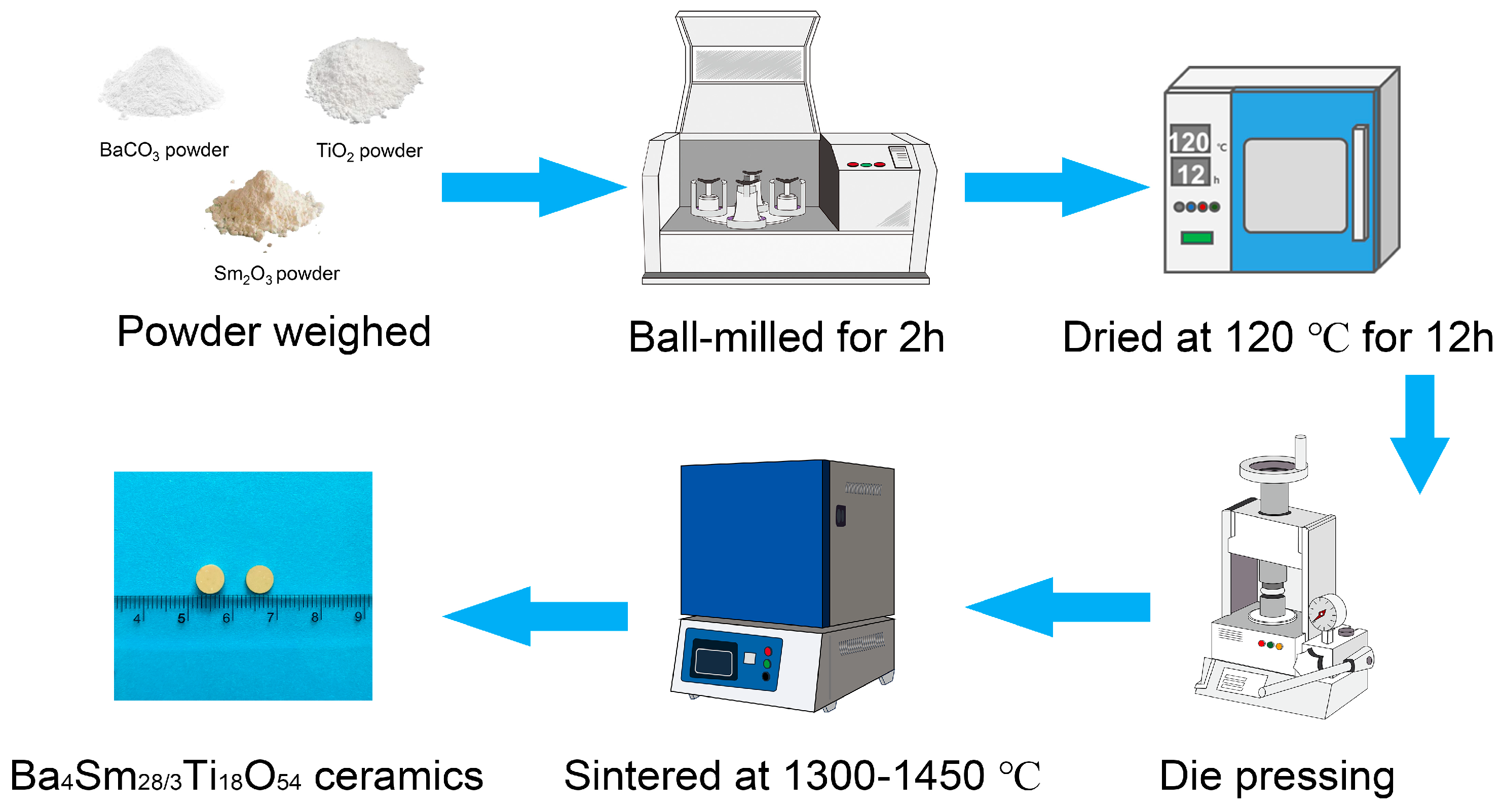
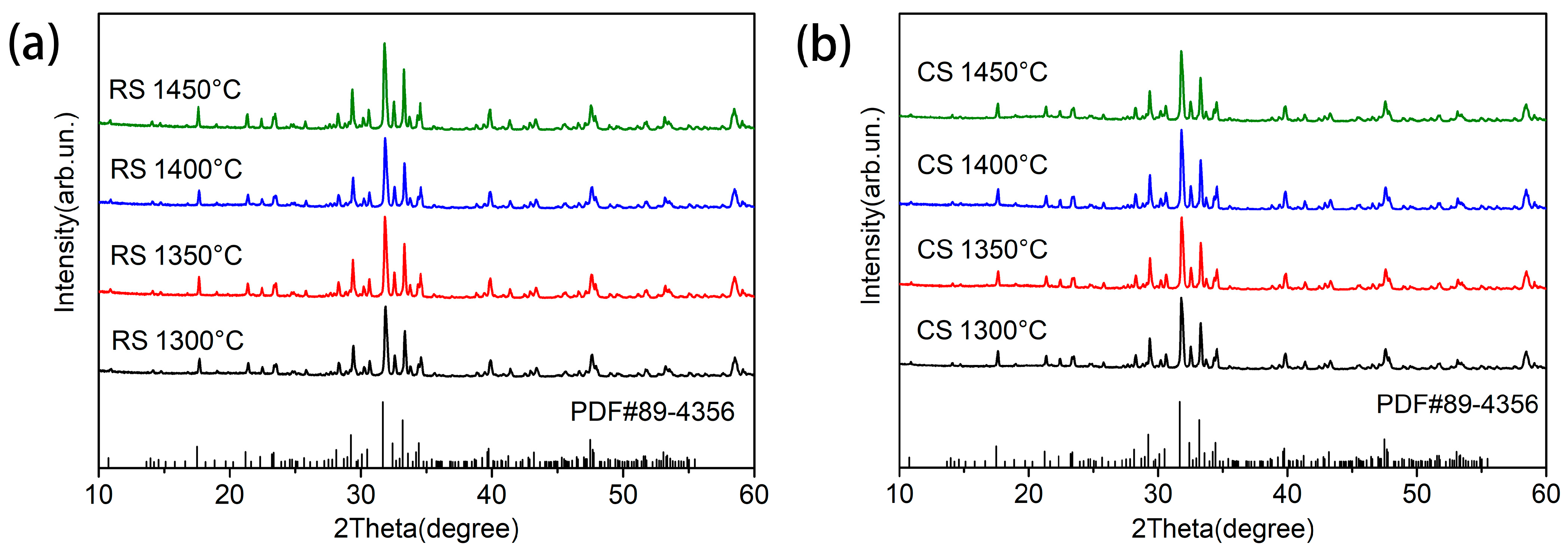
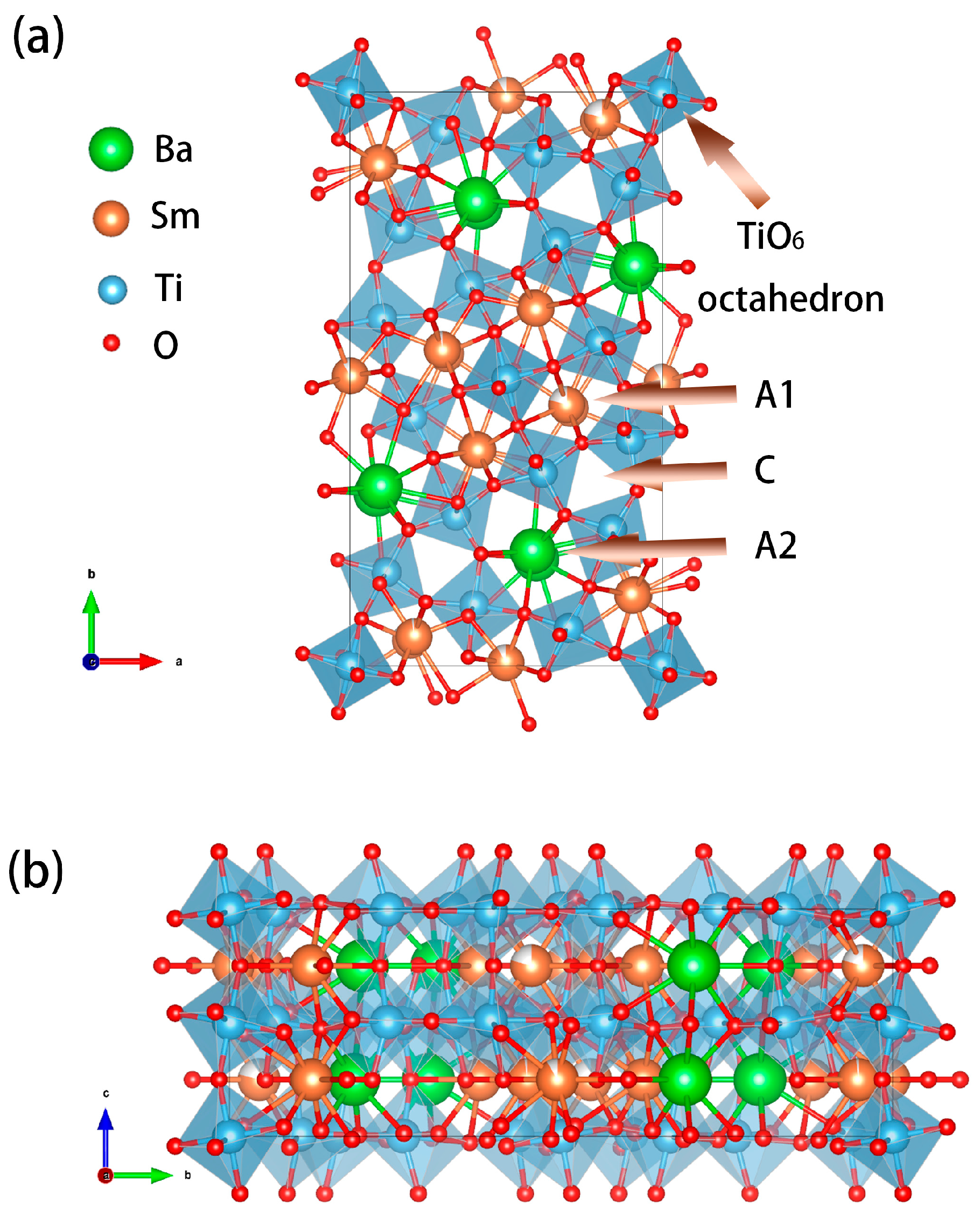
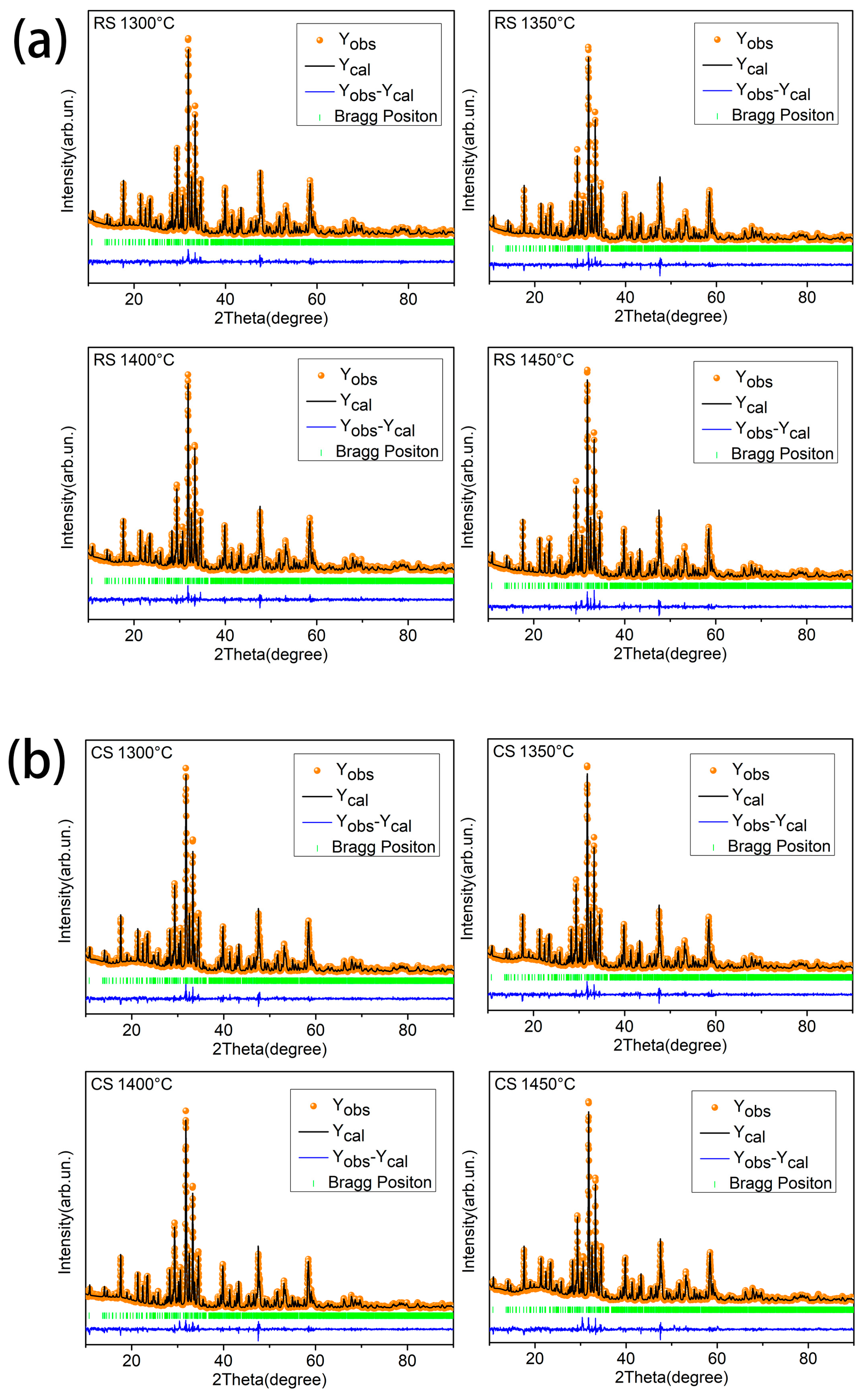


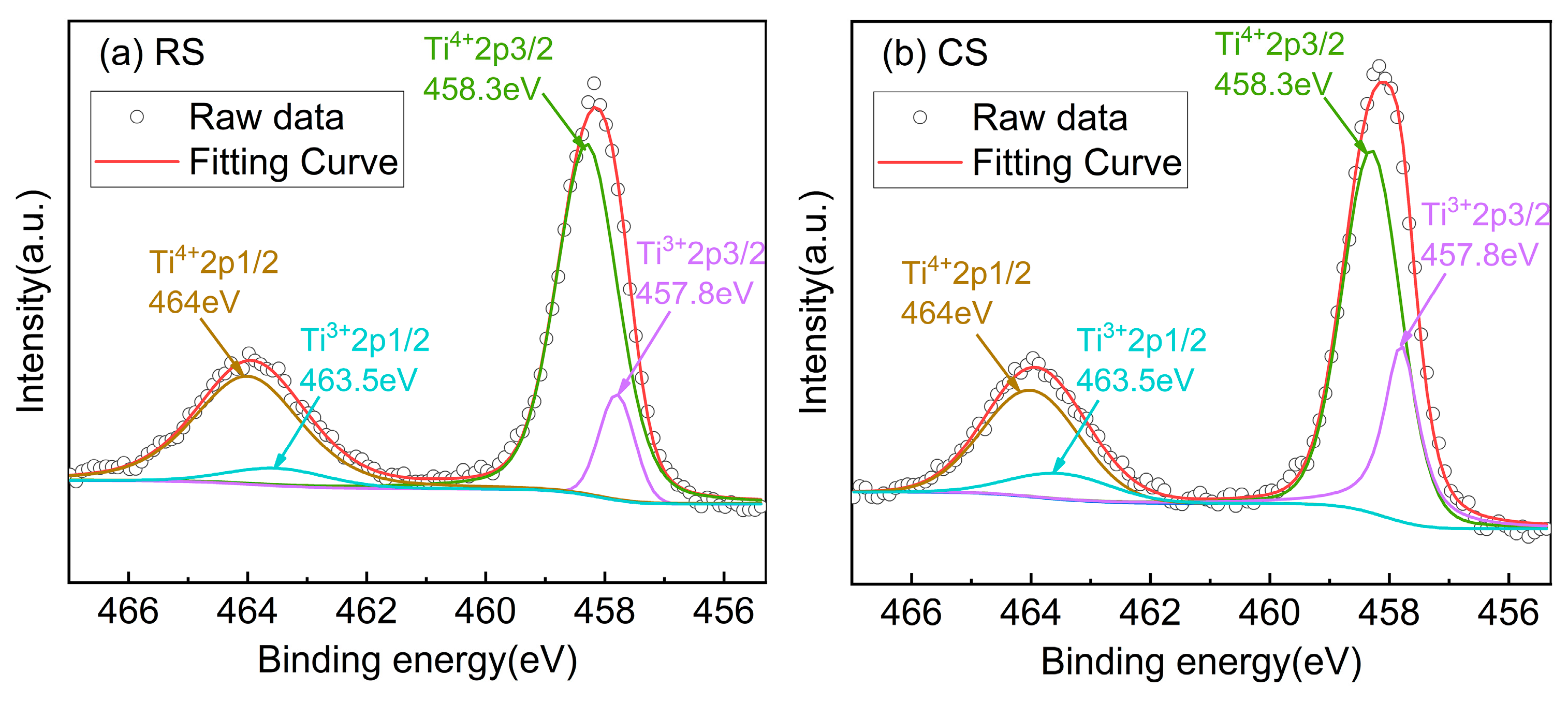
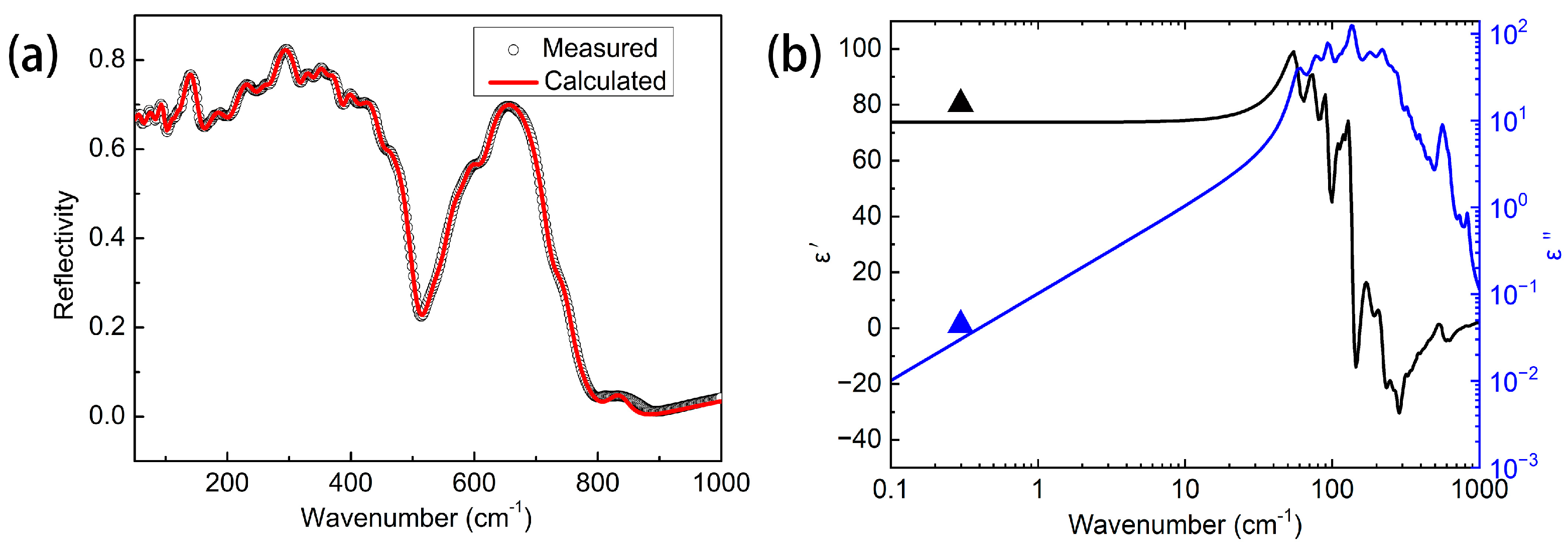
| Method | RS | CS | ||||||
|---|---|---|---|---|---|---|---|---|
| S.T. | 1300 °C | 1350 °C | 1400 °C | 1450 °C | 1300 °C | 1350 °C | 1400 °C | 1450 °C |
| a (Å) | 12.1524 | 12.548 | 12.1476 | 12.1513 | 12.156 | 12.1548 | 12.1596 | 12.1601 |
| b (Å) | 22.298 | 22.3001 | 22.2878 | 22.2946 | 22.307 | 22.3037 | 22.312 | 22.3134 |
| c (Å) | 7.6636 | 7.6637 | 7.659 | 7.6614 | 7.6612 | 7.6608 | 7.6633 | 7.6637 |
| V (Å3) | 2076.983 | 2077.279 | 2073.65 | 2075.567 | 2077.456 | 2076.841 | 2079.12 | 2079.458 |
| α = β = γ | 90 | 90 | 90 | 90 | 90 | 90 | 90 | 90 |
| Rp (%) | 5.86 | 6.26 | 6.03 | 6.37 | 5.79 | 5.94 | 6.00 | 6.14 |
| Rwp (%) | 7.58 | 8.04 | 7.62 | 8.23 | 7.44 | 7.69 | 8.01 | 8.37 |
| χ2 (%) | 1.38 | 1.6 | 1.45 | 1.71 | 1.55 | 1.59 | 1.81 | 2.04 |
| ρth (g/cm3) | 5.883 | 5.882 | 5.893 | 5.886 | 5.88 | 5.884 | 5.875 | 5.876 |
| Method | Measured | Calculated | ||||||
|---|---|---|---|---|---|---|---|---|
| εr | Q × f (GHz) | f (GHz) | tanδ | TCF (ppm/°C) | εthe | P.F. (%) | VTi (v.u.) | |
| RS (1400 °C) | 80.26 ± 0.5 | 9519 ± 100 | 5.882 | 6.18 × 10−4 ± 0.07 × 10−4 | −7.9 ± 1 | 43.27 | 71.88 | 4.136 |
| CS (1400 °C) | 79.38 ± 0.5 | 8230 ± 100 | 6.211 | 7.55 × 10−4 ± 0.09 × 10−4 | −12.1 ± 1 | 41.65 | 71.69 | 4.109 |
| Method | Binding Energy (eV) | Binding Energy (eV) | Relative Peak Area Ratio (%) | ||
|---|---|---|---|---|---|
| Ti2p1/2 | Ti2p3/2 | Ti3+/(Ti3+ + Ti4+) | |||
| IV | III | IV | III | ||
| RS (1400 °C) | 464 | 463.5 | 458.3 | 457.8 | 11.87% |
| CS (1400 °C) | 464 | 463.5 | 458.3 | 457.8 | 27.63% |
| No | Method | S.T. | C.T. | εr | Q × f | TCF | Ref. |
|---|---|---|---|---|---|---|---|
| (°C) | (°C) | (GHz) | (ppm/°C) | ||||
| 1 | Sol–gel | 1360 °C for 3 h | 1000 °C for 3 h | 80.8 | 10,099 | [34] | |
| 2 | Spark plasma sintering (SPS) | 1200 °C for 5 min | 1100 °C for 2 h | 81.2 | 10,099 | −17.2 | [35] |
| 3 | Conventional solid-state (CS) | 1360 °C for 3 h | 1200 °C for 3 h | 81 | 9240 | −10.6 | [27] |
| 4 | Conventional solid-state (CS) | 1350 °C for 4 h | 1175 °C for 4 h | 76 | 10,025 | −12 | [33] |
| 5 | Conventional solid-state (CS) | 1400 °C for 4 h | 1150 °C for 3 h | 79.38 ± 0.5 | 8230 ± 100 | −12.1 ± 1 | This work |
| 6 | Reaction sintering (RS) | 1400 °C for 4 h | No calcining | 80.26 ± 0.5 | 9519 ± 100 | −7.9 ± 1 | This work |
| Mode | ωoj | ωpj | γj | ∆εj |
|---|---|---|---|---|
| 1 | 59.372 | 150.39 | 12.98 | 6.42 |
| 2 | 77.686 | 215.05 | 15.459 | 7.66 |
| 3 | 94.164 | 265.45 | 12.737 | 7.95 |
| 4 | 110.92 | 170.5 | 11.841 | 2.36 |
| 5 | 119.79 | 143.96 | 9.8071 | 1.44 |
| 6 | 136.27 | 549.38 | 20.392 | 16.3 |
| 7 | 180.78 | 608.44 | 47.303 | 11.3 |
| 8 | 220.41 | 651.18 | 40.424 | 8.73 |
| 9 | 254 | 397.26 | 33.883 | 2.45 |
| 10 | 276.38 | 393.1 | 29.563 | 2.02 |
| 11 | 321.14 | 233.55 | 25.539 | 0.529 |
| 12 | 342.62 | 193.1 | 25.398 | 0.318 |
| 13 | 364.24 | 135.29 | 24.327 | 0.138 |
| 14 | 389.39 | 158.91 | 22.899 | 0.167 |
| 15 | 415.22 | 210.92 | 44.179 | 0.258 |
| 16 | 455.19 | 129.34 | 31.593 | 0.0807 |
| 17 | 473.33 | 121.35 | 44.58 | 0.0657 |
| 18 | 533.19 | 212.21 | 39.59 | 0.158 |
| 19 | 559.52 | 378.82 | 41.725 | 0.458 |
| 20 | 584.43 | 267.57 | 42.129 | 0.21 |
| 21 | 617.56 | 238 | 43.317 | 0.149 |
| 22 | 732.06 | 95.576 | 42.165 | 0.017 |
| 23 | 776.86 | 82.733 | 65.188 | 0.0113 |
| 24 | 829.14 | 158.21 | 50.895 | 0.0364 |
Disclaimer/Publisher’s Note: The statements, opinions and data contained in all publications are solely those of the individual author(s) and contributor(s) and not of MDPI and/or the editor(s). MDPI and/or the editor(s) disclaim responsibility for any injury to people or property resulting from any ideas, methods, instructions or products referred to in the content. |
© 2024 by the authors. Licensee MDPI, Basel, Switzerland. This article is an open access article distributed under the terms and conditions of the Creative Commons Attribution (CC BY) license (https://creativecommons.org/licenses/by/4.0/).
Share and Cite
Li, Z.; Zhou, H.; Xiong, G.; Wang, H.; Wang, G. Crystal Structure, Infrared Reflection Spectrum, and Improved Microwave Dielectric Characteristics of Ba4Sm28/3Ti18O54 Ceramics via One-Step Reaction Sintering. Materials 2024, 17, 3477. https://doi.org/10.3390/ma17143477
Li Z, Zhou H, Xiong G, Wang H, Wang G. Crystal Structure, Infrared Reflection Spectrum, and Improved Microwave Dielectric Characteristics of Ba4Sm28/3Ti18O54 Ceramics via One-Step Reaction Sintering. Materials. 2024; 17(14):3477. https://doi.org/10.3390/ma17143477
Chicago/Turabian StyleLi, Zeping, Huajian Zhou, Gang Xiong, Huifeng Wang, and Geng Wang. 2024. "Crystal Structure, Infrared Reflection Spectrum, and Improved Microwave Dielectric Characteristics of Ba4Sm28/3Ti18O54 Ceramics via One-Step Reaction Sintering" Materials 17, no. 14: 3477. https://doi.org/10.3390/ma17143477




